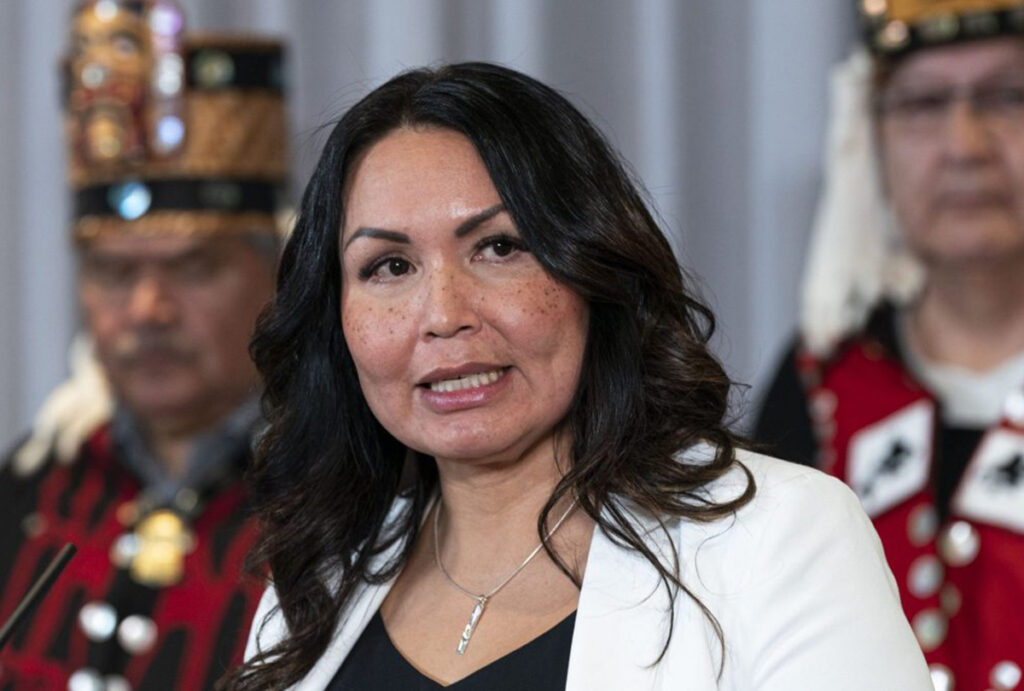‘Now we are working together to make our own opportunities as owners and developers of the resource’
By Will Gibson
Follow CEC on LinkedIn CEC LinkedIn
Follow CEC on Facebook CEC Facebook
Follow CEC on Twitter CEC Twitter

Haisla Nation Chief Councillor Crystal Smith during a press conference announcing that the Cedar LNG project has been given environmental approval in Vancouver, Tuesday March 14, 2023. CP Images photo
Growing up in the 1980s, Crystal Smith felt supported and nourished by her community, the Haisla Nation along the shores of Kitimat, British Columbia. But at the same time, she also sensed the outside world had placed some limitations on her future.
“I enjoyed a wonderful childhood with a solid foundation and lots of love, especially from my grandma Cecilia Smith. She raised me because I lost my mother and stepdad at a young age. But it wasn’t popular to be Indigenous when I grew up,” says Smith.
“A lot of people would talk about how Indigenous people were not expected to be successful. That kind of talk really affected my confidence about what I could be.”
Smith, now the Haisla Nation’s elected chief councillor, never wants children in her community to feel those constraints.
Her community has seized on a major opportunity to build prosperity and resiliency for future generations. The Haisla Nation is a partner in the proposed $3.4 billion Cedar LNG project, the world’s first to have Indigenous ownership. A final go-ahead decision for the project to proceed is expected by the middle of this year.
Smith, who has served as board chair of the First Nations LNG Alliance since 2019, has already seen tangible changes in her community since the project was announced.
“It’s hard to put into words about the impact on the ground in terms of how this opportunity has affected our members in their lives,” she says.
“We were just interviewing candidates to serve as board directors on our economic development corporation and one candidate, who is from our community, just amazed me with how far he has come in terms of pursuing his education and how much his career has progressed.”

The town of Kitimat on British Columbia’s west coast. LNG Canada site in background. Photo courtesy District of Kitimat
Of her own career, Smith says she knew since college that her future was in serving the community. She started working in the Haisla band administration in 2009 and was first elected chief councillor in 2017.
“I was lucky because my family really pushed me to seek an education after high school, so I took the business program at Coast Mountain College. I also helped that I had mentors in my community, including my father Albert Robinson, who served as an elected Haisla councillor, and Ellis Ross (now an elected MLA in B.C), who was very inspiring in terms of his vision as chief councillor and encouraged me to take the step into elected office,” Smith says.
“When I came back to the community from school, I knew I would end up working in our band office. I wanted to see more opportunities for people in my community and LNG provides that.”
She already sees the benefits of the development, as well as the Haisla Nation’s participation in the LNG Canada project, within her own family including for her grandsons.
“Xavier is six and he goes to the same school I attended as a child. He gets to learn parts of our culture, our teachings, as well as the value and importance of family and community. There’s more of an emphasis on our language and culture in the curriculum, which really makes me happy. Luka, who just turned two, will also attend that school when he’s old enough,” Smith says.
“I want programs and services to meet our needs, not the level of government’s needs. And we need to make sure that it is sustainable not just for my grandsons or their peers but for seven generations beyond this one.”
Cedar LNG is coming closer and closer to fruition, with all permits in place and early construction underway.
An eight-kilometre pipeline will be built connecting the recently completed Coastal GasLink pipeline to deliver natural gas to the floating Cedar LNG terminal located along the Douglas Channel near Kitimat.
The facility will be capable of producing up to three million tonnes of liquefied natural gas every year, which will be transported by carriers through the Douglas Channel to Hecate Straight, using the existing deepwater shipping lane, to reach customers in the Asia-Pacific region.
Powered entirely by renewable energy from BC Hydro, Cedar LNG will be one of the lowest carbon intensity LNG facilities in the world. Its so-called emissions intensity will be 0.08 per cent CO2 per tonne, compared to the global average of 0.35 per cent per tonne.

Rendering courtesy Cedar LNG
Up to 500 people will work on the project during the peak of construction. Approximately 100 people will be working at the facility full-time during operation, which is expected to start in the second half of 2028.
Smith says the benefits of the project will extend beyond the 2,000 members of the Haisla Nation.
“This work has really helped us reconnect with other Indigenous communities along pipelines and shipping routes,” she says.
“When I was growing up, our communities never had the opportunity to come together because we were separated by the territorial boundaries imposed by the Indian Act. And we were fighting each other for financial scraps from Indian Affairs.
“Now we are working together to make our own opportunities as owners and developers of the resource. That’s very empowering and the most important part. Participating in developing these resources provides independence. It’s the only solution for my nation and other Indigenous communities.”
The unaltered reproduction of this content is free of charge with attribution to Canadian Energy Centre Ltd.
Share This:




